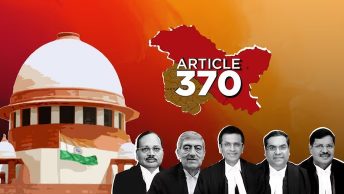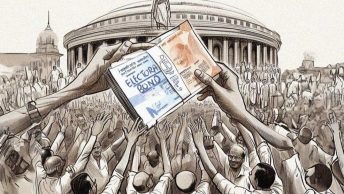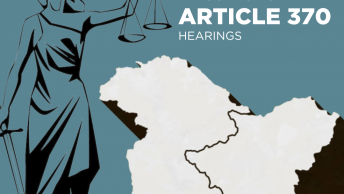In an interview with the BBC, the Pakistani singer Ali Sethi spoke of zamana (loosely translated as, the times one lives in) being the ultimate muse in Urdu poetry, or the ‘great enemy’. For, to be out of sync with zamana, was akin to experiencing persecution.
An echo of this sentiment, but arguably misplaced, was found in a significant interim order by the Supreme Court dated 11 May 2022, in a matter adjudging the constitutionality of sedition.
Among other things the court said, “it is clear that the Union of India agrees with the prima facie opinion expressed by this Court that the rigours of Section 124A of IPC is not in tune with the current social milieu, and was intended for a time when this country was under the colonial regime.”
Is sedition, however, only an image of our colonial past, or are there ways in which it manifests around us even today, that a constitutional court must be attentive to?
To answer this question, I will engage with two studies. One, Dr. Anushka Singh’s Sedition in Liberal Democracies, and two, A Decade of Darkness–an Article-14 led empirical and qualitative study into the use of sedition from 2010. I will demonstrate the phenomenon of “everydayness”, or how sedition is used by the executive, and why, therefore, short of striking down the law, no guideline can regulate its use.
It is my contention that there are two distinct manifestations of everydayness that are visible: one, the very fact that sedition charges are being filed against people engaged in everyday acts where protest, dissent or criticism is noticeably absent in their expressions. In the making of A Decade of Darkness, this finding forced us to shatter our original premise about who is ‘seditious’. We discovered that outspoken critics, protestors, or anyone challenging the socio-political status quo, are not the only targets.
And two, the everyday life of the law inside police stations. It discloses a set of impossible-to-overcome realities behind the legislative[1] and judicial language[2] of sedition that sought to partially emancipate it from precisely those realities.
Further, in the current discourse on sedition, and therefore in this article, the focus is on how and why FIRs are filed, i.e., the pre-trial process. This is the stage where the most damage is inflicted, in terms of the speed and certainty of arrest.
Before that however, it would be useful to study the interim order by the Supreme Court dated 11 May 2022.
What the Supreme Court Held
Between the 5th of May 2022 and the 11th of May 2022, there were multiple stakeholders before the Supreme Court, being heard on the constitutionality of sedition. With the government on one side, and eight petitioners on the other, we saw views being presented that led to the court passing an order on 11 May 2022 staying the operation of Section 124A.
On 5 May 2022, the attorney general orally submitted before the court that Kedar Nath Singh vs State of Bihar (1962), which upheld the validity of the sedition law, is good law and that sedition can remain in the statute books. He also brought up a recent case filed against Navneet Rana and Ravi Rana for chanting the Hanuman Chalisa, as an instance of misuse of the law, and therefore guidelines could be laid down to prevent this kind of misuse.
On 7 May 2022, the solicitor general, in his written submissions, which mirrored that of the attorney general, urged that Section 124A not be reconsidered and further that individual instances of misuse are not a ground to invalidate the provision.
However, on 9 May 2022, the additional secretary to the government of India, ministry of home affairs filed an affidavit before the Supreme Court stating that “the Hon’ble PM believes that at a time when our nation is marking ‘Azadi Ka Amrit Mahotsav’ (75 years since independence) we need to, as a nation, work even harder to shed colonial baggage that has passed its utility, which includes outdated colonial laws and practices.” The affidavit urged the court to “not invest time in examining the validity of sedition once again” and wait for the Executive to reconsider the provision before an “appropriate forum”.
On 11 May 2022, the Supreme Court passed an order that said, “it is clear that the Union of India agrees with the prima facie opinion expressed by this Court that the rigours of Section 124A of IPC is not in tune with the current social milieu, and was intended for a time when this country was under the colonial regime.” The apex court went on to say that they “hope and expect that the State and Central Governments will restrain from registering any FIR, continuing any investigation or taking any coercive measures by invoking Section 124A of IPC while the aforesaid provision of law is under consideration.” It also stated that the Union of India may issue a directive to the State Governments/Union Territories to prevent any misuse of Section 124A of IPC.
That the Supreme Court “hopes” for the government not to file FIRs invoking sedition, is, therefore, a misplaced sentiment in this political climate. Soon after this order, the law minister, Kiren Rijiju, said that while he respected the court, there is a “lakshman rekha” that cannot be crossed. Public statements such as these only reiterate the vagueness that already exists around sedition, and consequently how the police may interpret this provision.
(A more detailed critique of the interim order dated 11 May 2022 is available here)
Having said this, what lessons from the everyday use of sedition laws should the judiciary remember when adjudging the constitutionality of sedition in the future?
Lubhyathi Rangarajan is Editor-Databases at Article-14. Acknowledgements are due to Dhirendra Jha, Mohit Rao and Makepeace Sithou for investigative reportage from Uttar Pradesh, Karnataka and Assam, for A Decade of Darkness. Parts of this article have been reproduced with permission from an article originally published for Article-14 on 12 May 2022.
Disclosure: Dr. Anushka Singh was an Advisor to A Decade of Darkness.
[Editor’s Note: This article was edited by Shravani Shendye and published by Avani Vijay from the student editorial team.]
[1] Section 124A of the Indian Penal Code expressly prohibits non-violent criticism from its operation.
[2] Kedar Nath Singh v. State of Bihar declares that only incitement to violence can be considered to fall within the meaning of sedition.






[…] Posted byLubhyathi Rangarajan […]
84hb8p
29qr1v
Your blog stands out in a sea of generic and formulaic content Your unique voice and perspective are what keep me coming back for more
I just like the helpful information you provide in your articles
Looking forward to your next post. Keep up the good work!
Can you be more specific about the content of your article? After reading it, I still have some doubts. Hope you can help me.
Good post! We will be linking to this particularly great post on our site. Keep up the great writing
Nice post. I learn something totally new and challenging on websites
I truly appreciate your technique of writing a blog. I added it to my bookmark site list and will
I just like the helpful information you provide in your articles